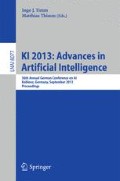Abstract
Move prediction systems have always been part of strong Go programs. Recent research has revealed that taking interactions between features into account improves the performance of move predictions. In this paper, a factorization model is applied and a supervised learning algorithm, Latent Factor Ranking (LFR), which enables to consider these interactions, is introduced. Its superiority will be demonstrated in comparison to other state-of-the-art Go move predictors. LFR improves accuracy by 3% over current state-of-the-art Go move predictors on average and by 5% in the middle- and endgame of a game. Depending on the dimensionality of the shared, latent factor vector, an overall accuracy of over 41% is achieved.
Access this chapter
Tax calculation will be finalised at checkout
Purchases are for personal use only
Preview
Unable to display preview. Download preview PDF.
References
Kocsis, L., Szepesvári, C.: Bandit based Monte-Carlo Planning. In: Fürnkranz, J., Scheffer, T., Spiliopoulou, M. (eds.) ECML 2006. LNCS (LNAI), vol. 4212, pp. 282–293. Springer, Heidelberg (2006)
Gelly, S., Wang, Y.: Exploration exploitation in Go: UCT for Monte-Carlo Go. In: NIPS: Neural Information Processing Systems Conference On-line trading of Exploration and Exploitation Workshop, Canada (December 2006)
Stern, D., Herbrich, R., Graepel, T.: Bayesian Pattern Ranking for Move Prediction in the Game of Go. In: ICML 2006: Proceedings of the 23rd International Conference on Machine Learning, pp. 873–880. ACM Press, New York (2006)
Wistuba, M., Schaefers, L., Platzner, M.: Comparison of Bayesian Move Prediction Systems for Computer Go. In: CIG, pp. 91–99. IEEE (2012)
Rendle, S.: Factorization Machines. In: 2010 IEEE 10th International Conference on Data Mining (ICDM), pp. 995–1000 (2010)
van der Werf, E., Uiterwijk, J.W.H.M., Postma, E.O., van den Herik, H.J.: Local Move Prediction in Go. In: Schaeffer, J., Müller, M., Björnsson, Y. (eds.) CG 2002. LNCS, vol. 2883, pp. 393–412. Springer, Heidelberg (2003)
Sutskever, I., Nair, V.: Mimicking Go Experts with Convolutional Neural Networks. In: Kůrková, V., Neruda, R., Koutník, J. (eds.) ICANN 2008, Part II. LNCS, vol. 5164, pp. 101–110. Springer, Heidelberg (2008)
Coulom, R.: Computing Elo Ratings of Move Patterns in the Game of Go. ICGA Journal 30(4), 198–208 (2007)
Araki, N., Yoshida, K., Tsuruoka, Y., Tsujii, J.: Move Prediction in Go with the Maximum Entropy Method. In: IEEE Symposium on Computational Intelligence and Games, CIG 2007, pp. 189–195 (2007)
Müller, M.: Computer Go. Artificial Intelligence 134, 145–179 (2002)
Lichtenstein, D., Sipser, M.: GO Is Polynomial-Space Hard. J. ACM 27(2), 393–401 (1980)
Crâsmaru, M., Tromp, J.: Ladders are PSPACE-Complete. In: Marsland, T., Frank, I. (eds.) CG 2001. LNCS, vol. 2063, pp. 241–249. Springer, Heidelberg (2002)
Weng, R.C., Lin, C.J.: A Bayesian Approximation Method for Online Ranking. Journal of Machine Learning Research 12, 267–300 (2011)
Author information
Authors and Affiliations
Editor information
Editors and Affiliations
Rights and permissions
Copyright information
© 2013 Springer-Verlag Berlin Heidelberg
About this paper
Cite this paper
Wistuba, M., Schmidt-Thieme, L. (2013). Move Prediction in Go – Modelling Feature Interactions Using Latent Factors. In: Timm, I.J., Thimm, M. (eds) KI 2013: Advances in Artificial Intelligence. KI 2013. Lecture Notes in Computer Science(), vol 8077. Springer, Berlin, Heidelberg. https://doi.org/10.1007/978-3-642-40942-4_23
Download citation
DOI: https://doi.org/10.1007/978-3-642-40942-4_23
Publisher Name: Springer, Berlin, Heidelberg
Print ISBN: 978-3-642-40941-7
Online ISBN: 978-3-642-40942-4
eBook Packages: Computer ScienceComputer Science (R0)

